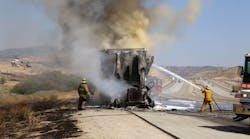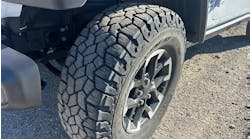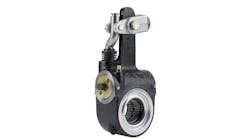Editor’s Note: Editorial has honored the request to keep the carrier source in this article anonymous.
When a road incident involving a commercial vehicle results in a fire, it can lead to extensive damage – both to surrounding property and the vehicle itself. Worse yet, catastrophic vehicle thermal events can cause severe injury or death to drivers, the motoring public and innocent bystanders.
While truck fires are a relatively rare occurrence, the resulting outcomes can have a lasting impact. This is why it is critical to find ways to help mitigate thermal events.
The usual suspects
Attendees of the Technology & Maintenance Council’s 2018 Fall Meeting Technical Discussion on diagnosing thermal events were surveyed to provide insight on the presumable root causes of thermal events within their fleets. Respondents indicated a relatively even split among a number of factors: 33 percent indicated the primary root cause tended to be mechanical, with another 33 percent advising wheel bearings were the primary culprit. Pneumatic causes accounted for about a quarter of thermal event issues, while tires attributed to 12 percent.
There are some primary areas fleets can monitor in order to better track thermal events in these categories, such as tires, wheels, brakes and the air system.
Abnormal tire temperature can be a significant indicator of a potential thermal event. Phil Arnold, military technical manager for Michelin North America, advises normal operating temperature range for a tire should be between 100 and 150 degrees F.
“When first starting operation, tires will take some time to reach a steady temperature, but will reach a point where the heat generated by the normal flexing of the tire is offset by the cooling airflow across the tire,” he explains.
As this temperature range increases, it can impact various other aspects of the operating vehicle. At 200 to 300 degrees F, the higher temperature can impact other adjacent components. Between 500 and 550 degrees F, a flammable vapor starts to form, and burning occurs around 650 to 700 degrees F.
There are a number of examples Arnold sites which may lead to a thermal event, including:
- A dragging brake, which transfers heat to the wheel rim and tire. This occurs when the brake pad does not release completely after the brake pedal is no longer engaged.
- Improperly adjusted wheel bearings can cause friction between components.
- Improper tire inflation pressure, such as insufficient or underinflated tires, can elevate temperatures and lead to rapid air loss.
- A flat tire in a dual configuration can cause friction between the flat tire and the road surface, causing excessive heat. In addition, steel from a tire’s sidewall can also come into contact with the road, which may cause sparking “much like dragging a chain behind a truck.”
Air leaks are another major concern when it comes to the cause of thermal events. This is because when an air leak occurs, it limits the amount of compressed air to the air brake system. Air in the air brake system keeps the springs from engaging in the brake chamber.
Another issue that may occur with the air system, especially when it comes to double and triple trailers, is false charging.
False charging occurs when air is cut off or blocked from the air supply line to all the trailers. It can be caused due to a kinked air hose, or a closed or partially opened air supply valve. Air already in the line from a previous haul may give the appearance that air is supplied to the trailer, when in fact, the reserve tank will empty once the service brakes are used again.
“If this happens, the air in the rear trailer reservoir cannot be replenished and will deplete over time through service applications and general air system leakage,” explains John Ripley, vehicle systems engineer with Bendix Commercial Vehicle Systems. “When the air pressure gets too low, the spring brakes will begin to reapply, causing brake drag, which has the potential to help lead to a thermal event.”
How far the vehicle has traveled when the thermal event occurs can be a good indicator of what caused the issue. For instance, if a thermal event occurs between 30 and 50 miles into the trip, it could be attributed to brakes that are adjusted too tightly or an air leak issue. A false charge may occur during the beginning of the trip as well – typically within 25 to 80 miles, depending on how much the service brake is used at the start of the trip.
The role of aerodynamics
Recent industry discussions have examined the implementation of aerodynamic devices on trailers, and the possible correlation of increased thermal events.
A maintenance director from a national carrier, responsible for overseeing a fleet that had nearly half of its more than 25,000 trailers outfitted with trailer skirts over the course of a year, provided some insight.
He believes, after thorough data collection and analysis, that trailer skirts are not the direct cause behind increased thermal events. But, these devices can potentially compound a problem with one of the known usual culprits – such as a dragging brake or underinflated tire.
“One of the first things I started noticing when we put skirts on – one of the things I do is I look at my tires that are coming back off the road,” the maintenance director explains. “I started noticing we had less and less of what I referred to as ‘donuts.’ What that drove me to understand was that when we were getting a flat tire years ago, because of the air flow without the skirts, it was keeping the tire’s combustion temperature down below that temperature range. Once we put the skirts up there, the air flow was reduced and the temperature of the tires increased and the tires lit off.”
In other words, the “donuts” did not have the opportunity to wear as they had in the past, because a thermal event would occur before they formed.
“We got away with a lot years ago that we can’t get away with today, because the [trailer] skirts take those smaller things and exacerbated into a flame,” he adds.
“At first it was culture shock, but we adapted and adjusted very well because we had to,” the maintenance director says. “That’s like learning how to diagnose thermal events – I was told by several people ‘Once a trailer burns up, you can’t figure out what’s wrong with it.’ I know better, because I do it all the time. But, it’s because I was forced to.”
Post-event analysis
It is important to create a standardized investigation process after a thermal event occurs. Analysis and collection of this information can help to mitigate future vehicle thermal events.
In the case of the major fleet interviewed, establishing a rigorous and standardized evaluation process, which includes a substantial collection of data, has allowed the fleet to lower its occurrence of thermal events.
Define a thermal event
Wherever heat is generated, there is a potential to cause a fire.
It can be extremely difficult, if not impossible, to evaluate the root cause of a vehicle fire. This is especially the case when there is a total loss of the vehicle.
“When I started collecting data, I needed a baseline of what am I collecting data on,” the maintenance director explains. “I backed out of it – what’s the difference between a trailer burning down and a wheel bearing getting hot? The difference was the absence of flame. The only difference was that it didn’t light up, it’s not that it [the thermal event] didn’t happen.”
In order to analyze the root cause of thermal events before they become catastrophic, the maintenance director suggests assessing and monitoring hot wheel ends. Tracking instances of when a wheel end becomes hot – without flames present – can help fleets establish a baseline for thermal events.
He says establishing this baseline has allowed the fleet to confirm areas of the vehicle that may have been lacking inspection, or may have not been considered an issue previously, in both the maintenance department or with drivers.
Create a dedicated team
A panelist representing a fleet at the TMC technical session suggested creating a dedicated person or team as the point of contact for handling the data collection and analysis of thermal events. It is important that this team be very meticulous and pay exceptional attention to detail.
Investigate at the scene
By communicating with all departments to understand the process, a fleet can have everyone on board to address thermal events. The first step is to investigate the scene of the event right after it occurs.
“In the beginning, every piece of equipment that had a thermal event …we would do an investigation right there on the spot,” explains the maintenance director. “Or, if we had to get it off the highway, wherever it was moved to, we would do an investigation. We wouldn’t break the sets up. That’s extremely important.”
As soon as a thermal event occurs for this fleet, the point person or team in charge of thermal event analysis is alerted, as well as the regional manager in charge of the vehicle involved. The regional manager oversees the initial investigation and reports those findings to the breakdown department. This fleet created a specific thermal event analysis checklist for the initial investigation. The checklist is completed by the regional manager, and provided to the dedicated thermal events team for review.
It is important and necessary to take several photos of the different areas of the vehicle for analysis, and to keep record for comparison of potential future thermal events.
Data collection
“There was a trade-off. It was getting very time-consuming, and very costly to do this,” the maintenance director says of conducting a vehicle analysis right after the thermal event occurred. “But I felt, especially in the beginning, it was that important to get my hands wrapped around what was going on.”
Because this investigation process would take time, it could cause delays. The maintenance director says the first year or so of extensive data collection allowed him to collect enough information to create a baseline, where he was comfortable accommodating requests to separate the tractor and trailer, or otherwise adjust the investigation process to help prioritize deliveries.
It can be a challenge because the data is only as good as the information provided by the different departments. The maintenance director interviewed for this article says he challenged and questioned some of the information he received, sometimes opting to go on-site to the scene of the event in order to evaluate himself.
For instance, a tractor-trailer had burned to the ground and he did not believe the lack of reasoning behind why it had occurred.
“I had three different people look at this piece of equipment – the trailer was burned to the ground – every one of them told me they couldn’t find anything. I could not accept that,” he says.
“When a trailer burns down to the ground, there should four sets – a set of wire beads for every rim – I had one rim that didn’t have wire beads on it. My question was, where are these beads at? We actually went down the road 50 miles, and rode back up the road looking for debris and the tire. Long story short, not everyone is capable of doing this. Your data is only as good as what you’re getting fed back. That was the most difficult part for me. Was what I’m getting back true?”
Preventive maintenance, inspections and testing
There are a number of items both drivers and maintenance personnel can do on a regular basis to help mitigate thermal issues.
When it comes to drivers, pre-trip and en route inspections are critical to monitoring tires and wheels.
“The walkaround inspection of the vehicle before starting the day’s operation should include a verification of correct tire pressure and general visual inspection of the tires, wheels and wheel ends,” Michelin’s Arnold says. “Are the pressures of both tires in dual fitment within 5 psi of each other? Is there any road debris imbedded in a tire or any cuts or other damage present?”
Arnold emphasizes each tire have a valve cap, and to note any discoloration, rust streaks or leakage on the hub assembly as well.
For en route and post-trip inspections, Arnold also suggests to “also note any indications of excessive heat coming from the tire/wheel assembly or the axle end.”
In addition to thorough tire and wheel inspections, all drivers should be trained on how to conduct a LABS test. LABS, which stands for leaks, alarms, buttons and service brake, should be incorporated into the pre-trip inspection process for all drivers prior to the start of their hours of service for the day. In particular, the leakdown test is critical to test for leaks in the air brake system (see sidebar[ES2] ).
During the TMC Fall Meeting Technical Session, suggestions to help prevent thermal events as it relates to the maintenance team’s role included the possibility of making updates or changes to the preventive maintenance inspection process, scheduled regular replacement of certain pneumatic valves, and the implementation of inbound and/or outbound safety lane inspections.
As part of updates to PMs, consider investing in diagnostic tools and brake testing machines to regularly test the trailer braking system. Suppliers such as Bendix also provide dedicated classroom training on braking systems, where fleets can opt to send technicians for comprehensive training.
When conducting regular PMs, technicians should also be aware of telltale signs of a potential thermal event.
“Rims can show discoloration of the finish, distorted or charred areas in the rim flange or distortion of the entire rim, particularly on the side opposite the disc,” Arnold explains. “Tires exposed to high levels of heat can have hardened rubber in the bead area which can be very brittle and easily damaged during demounting. Very high temperatures in the bead area of the tire can lead to an unwrapping of the steel casing ply and, in extreme cases, may lead to a rapid loss of inflation in the bead area.”
It is important to note, “many of these symptoms mentioned will not be readily apparent until the tire is removed from the rim,” cautions Arnold.
When it comes to the air system, particularly for double and triple trailers utilizing dollies, there are extra steps fleets can implement to monitor potential issues. “A recommended best practice is to make sure your dolly air system is clean and dry, and all the valves are functioning correctly,” says Bendix’s Ripley.
Inbound and outbound safety lanes have become more prevalent with some fleets to conduct a general overview inspecting different areas of the vehicle.
“Safety lane can be very effective in preventing a vehicle hitting the road with a low or flat tire,” Arnold says. “In addition to identifying a tire which may cause issues, the safety lane concept is also very effective in resolving other issues which can lead to maintenance or regulatory challenges like roadside inspection violations for inoperative light bulbs.”
Considerations to vehicle specification changes
There are a number of component replacements and vehicle updates fleets can consider to help mitigate thermal events.
- Updates to trailer service brakes. When it comes to trailer service brakes, consider replacing the trolley bar with a button. This prevents accidentally engaging the trolley bar, or hanging items on the lever, which may inadvertently engage the trailer brakes.
- Closed glandhand seals. Open seals allow for debris to enter the air system, which can occur more readily when air lines are dropped or not properly stored when a tractor is not coupled with a trailer.
- Dummy gladhands for trailer dollies. Dummy gladhands provide air-tight shut-off without a gladhand seal. This removes the element of human error, if a driver does not open or close the valve when connecting and disconnecting trailers.
- Synchronized valves. These control valves are used to delay or control airflow from different areas of the braking system. Bendix offers the SV-4 valve, which can be used on converter dolly air systems. These valves are used to prevent automatic braking application on the lead trailer of a double or triple in the event of an emergency, and also help minimize the occurrence of false charging.
- ATIS and TPMS. While tire pressure monitoring systems aren’t as prevalent on today’s commercial vehicles compared to the mandates with passenger vehicles, automatic tire inflation systems are becoming more widely specified on trailers. “Both of these technologies offer the capability to provide an early warning of a pressure loss situation,” Michelin’s Arnold says. He adds that while providing driver notifications is necessary, it is also critical to have telematics capabilities which track and record this data. “A tire found low repeatedly, particularly after a maintenance action, may have a slow leak which can turn into a larger pressure loss quickly,” he adds. “TPMS and ATIS technologies on the market today have the capability to reliably catch and report these events – as long as the human side of the equation is listening.”
Conclusion
“What I’ve learned is there is no silver bullet at thermal events,” advises the maintenance director. “The problem is the little things in the system. If the system works 100 percent every time, you will never have a thermal event. But if you have one component in that system that fails, you will have a hot wheel end. And if you keep going down the road, it’s going to be a thermal event.”
As vehicle manufacturers continue to focus on improved fuel economy through implementing more aerodynamic devices and designs, it is imperative that fleets continue to be vigilant in conducting PMs, and educating drivers to conduct proper pre-trip inspections and alert maintenance staff to any issues.
It is also imperative to implement a thorough follow-up process to analyze thermal events.





